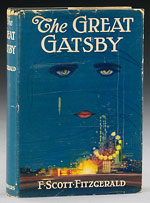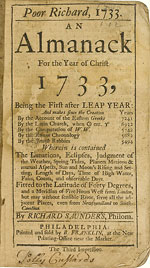Great Scott!
Collectors Throw Money at F. Scott Fitzgerald and Ben Franklin
The Eyes Have It
The Great Gatsby, Bonhams New York, $182,000
A copy of F. Scott Fitzgerald’s best known novel set a new auction record at Bonhams New York on June 10. Widely regarded as his most perfectly realized work, The Great Gatsby was published in New York in 1925. “I think my novel is about the best American novel ever written,” Fitzgerald bragged to Maxwell Perkins, his editor at Scribner’s, before publication.
Fitzgerald was equally forthright about Francis Cugat’s now iconic jacket design: “For Christ’s sake don’t give anyone that jacket you’re saving for me. I’ve written it into the book.” He may have been referring to the passage about “the eyes of Dr. T. J. Eckleburg” that stare out from a roadside billboard, or to Nick Caraway’s statement, “Unlike Gatsby and Tom Buchanan, I had no girl whose disembodied face floated along the dark cornices and blinding signs…” The eyes on Cugat’s jacket, however, are generally supposed to be those of Daisy Buchanan, and close examination of his artwork shows her pupils to be stylized reclining nudes.
For all that it was admired by leading literary figures, the book’s initial sales barely covered Fitzgerald’s advance, and most copies of the second printing were still in the Scribner’s warehouse when he died, his work almost forgotten, in 1940.
How very different things are today! This copy, from the M.B. Goldstone collection, shows some chipping and other wear, but it has all the issue points of a first printing and a jacket in the original state, with a lowercase j in Jay Gatsby’s name on the rear panel, corrected by hand.
Previous auction records include the $153,600 paid at Sotheby’s New York in 2004 for a very special copy from Maurice Neville’s collection. The jacket on that copy was from the corrected second printing, but it was inscribed by the author—and at a time when his books were mostly out of print, magazines no longer bought his stories and his Hollywood screenwriting career had come to a drunken end. Addressed to “Tat” Brown, Dean of Haverford College in Philadelphia and a noted collector, the book was poignantly inscribed “from one who is flattered at being remembered, F. Scott Fitzgerald, Hollywood, 1939.”
Rich Richard
Ben Franklin’s Almanack, Sotheby’s New York, $566,500
The principles of thrift espoused by the young Benjamin Franklin were more evident in the way Sotheby’s presented a rare copy of Poor Richard’s Almanack, than in the stratospheric bidding this historic little book produced. Just one little page from Sotheby’s new, environmentally-friendly mini-catalog was allocated to the sale of this copy, one of only three recorded copies of the first Poor Richard almanac.
In later life, the successful and prosperous Franklin found himself able to reconcile his reputation as the “Apostle of Thrift” with a very different lifestyle and the purchaser certainly ignored one of Franklin’s later Poor Richard aphorisms, “Buy what thou hast no need of, and ere long thou shalt sell thy necessities.” As Lauren Weber wrote in a piece on the sale for the Philadelphia Enquirer, Franklin himself would probably have enjoyed the irony of one of his poor almanacs selling for more than half a million dollars!
Franklin began writing his own almanacs, pseudonymously, when his printing shop lost the contracts for the printing of two others to a rival. Characterised by a mix of humour and pragmatic advice, much of it contained in the proverbs and aphorisms with which he sprinkled the text, the almanacs proved a huge success and as the title page illustration indicates, the first went into three impressions. An unfortunate transposition of the months September and October occasioned a second printing, while public demand brought the need for a third.
The signature of a previous owner, the charmingly named Polly Custards, appears on the title page, but this great rarity was only recently discovered in the collections of the Berwick (Pennsylvania) Historical Society. As befits their origin, the only other survivors are already housed in Philadelphia—a corrected first issue in the Rosenbach Museum & Library and another copy of the third impression with The Library Company.








 Ian McKay’s weekly column in Antiques Trade Gazette has been running for more than 30 years.
Ian McKay’s weekly column in Antiques Trade Gazette has been running for more than 30 years.
